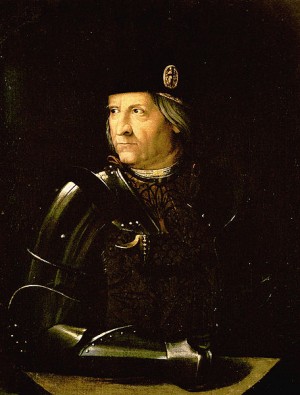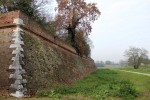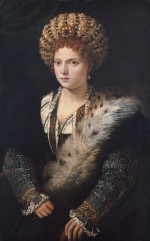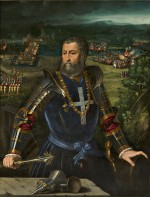Ercole I d'Este
Ariosto began his work as court writer with Ercole I d’Este. He wrote plays and put on theatrical performances, often praising his great munificence.
Ariosto at the Court of Ercole I d'Este
As a young man, little more than 20, Ariosto had assiduously frequented the court of Ercole I d’Este where he was court tributary, responsible for organising festivities and composing the scripts for theatrical events. His ambition included a stable position within the Este court, in one of the occupations usually reserved for humanists and men of letters, which would have ensured him a dignified and not excessively demanding life. The figure of Ercole was particularly heartfelt and acclaimed in Ariosto’s work and his poetry, into which Ariosto managed to weave praise of the Duke of Este’s greatness, both in civil enterprise and as a warrior, on multiple occasions.
“Lo! Hercules, who may reproach his neighbour,
With foot half burnt, and halting gait and slow,
That at Budrio, with protecting sabre,
He saved his troops from fatal overthrow;
Not that, for guerdon of his glorious labour,
He should distress and vex him as a foe;
Chased into Barco. It were hard to say,
If most he shine in peace or martial fray.
(Orlando Furioso, Canto 3, 46)
This episode refers to the help given by the Estes in the Venetian's war against the Florentines of the House of Medici. On this occasion, Ercole proved his valour in the battle of Budrio of 1467, losing three horses and being wounded on his right foot, but still managing to avoid the defeat of the Venetian army. Forgetting any gratitude it may have felt, Venice repaid the Duke by launching an attack on Ferrara in 1482, pushing on as far as Barco and the Delizia di Belfiore and sacking the churches of S. M. degli Angeli and the Certosa. The war with Venice ended in 1484, leaving Ferrara in a state of economic disarray. Following the tragic period of the Venetian war, the Duke confirmed himself to be a lover of jousting, tournaments, hunts, music, theatre and all festivities, reserving particular plaudits for Ariosto’s comedies.
The poet highlighted his passion for hunting, to which he dedicated the construction of the famous Barco within the Delizia di Belfiore, a huge park used as a private game reserve, filled with deer, hares and wild boar. But what undoubtedly sealed the fame and glory of Ercole was commissioning the drainage works which rescued Ferrara, at least in part, from the swamps which covered large areas of the territory, and above all for commissioning the enormous expansion of Ferrara's urban fabric known as the Addizione Erculea, which Ariosto did not fail to cite in Orlando Furioso. The predictions of the sage Melissa give unbounded praise to the Duke for the magnificent work performed for Ferrara:
To him his grateful city owes a debt,
The greatest subjects to their lord can owe;
Not that he moves her from a marsh, to set
Her stones, where Ceres’ fruitful treasures grow.
Nor that he shall enlarge her bounds, nor yet
That he shall fence her walls against the foe;
Nor that he theatre and dome repairs,
And beautifies her streets and goodly squares.
(Orlando Furioso, Canto 3, 48)
The Life of the Duke
Ercole I, son of Niccolò III and his third wife, Ricciarda di Saluzzo, was Marquis d’Este, and second Duke of Ferrara, Modena and Reggio from 1471. He married Eleanor of Naples in 1473, a wedding which followed the policy of conciliation towards the other Italian cities, but was seen in a poor light by Venice, which was suspicious of the alliances that the Duke was making. The Duchess Eleanor, a highly cultured woman, proved to be a wise and loyal consort, whose strength of character was decisive in building diplomatic relationships both within the court and with the other city states.
The tension between Ferrara and Venice boiled over into the war for the Polesine, which the Duke lost by signing the treaty of Bagnolo in 1484. As Duke, he pursued a policy of détente between the various states on the Italian peninsula. In 1494, when Italy was rocked by the battles with the invasion of Charles VIII’s French army, Ercole managed to avoid becoming involved in the conflict and instead took on the role of mediator between the French army and the various Italian armies. Ercole I d’Este indeed promoted a policy of peace which he tried to pursue above all through strategic marriages and alliances. He aimed to facilitate these through the numerous festivities, musical and theatrical performances held in Ariosto's time. Amongst the most important marriages arranged by Ercole were the 1491 nuptials of his first-born Alfonso with Anna Sforza, while in 1480 he promised the hand of his daughter Isabella to Francesco Gonzaga, Marquis of Mantua, and that of his other daughter Beatrice to Ludovico il Moro, Duke of Milan. A further example of his diplomatic skills was his ability to navigate between support to the troops of Louis XII who in 1499 was moving towards Italy, and the expansionist aims of the Papal States and the militancy of Cesare Borgia. He managed to avoid an alliance with France while nevertheless paying it tribute, and to make an agreement with the Pope, by marrying his son Alfonso, who had been widowed, to Lucrezia Borgia, sister of Cesare and illegitimate daughter of Pope Alexander VI in 1501.
The name of Ercole I d’Este is forever linked to improvement of the City of Ferrara, above all the expansion of the city walls thanks to the imposing works represented by the Addizione Erculea which he entrusted to Biagio Rossetti. He loved to fill his court with artists and poets, such as Boiardo and Ludovico Ariosto himself. Seriously ill following the wounds he suffered in the conflict with Venice, he died on 25 January 1505: “towards evening he sent for Vincenzo from Modena; and he had him play a pedal harpsichord for an hour, giving him great pleasure, and he beat the time with his hand” (Chiappini 2001, p. 230).
Bibliography
- Giulio Bertoni, L’Orlando furioso e la Rinascenza a Ferrara, Cav Orlandini, Modena 1919
- Gianna Pazzi, Ferrara antica e Ferrara d'oggi (1000-1927), Lunghini & Bianchini, Firenze 1929
- Renzo Renzi (a cura di), Ferrara, il Po, la Cattedrale, la Corte dalle origini al 1598, edizioni Alfa, Bologna 1969
- Ludovico Ariosto, Cesare Segre, Orlando furioso, I Meridiani Mondadori, Milano 1976
- Antonio Panizzi, Alessandro Marcigliano, La vita di Ariosto, Atti della Deputazione Provinciale Ferrarese di Storia Patria, SATE, Ferrara 1988
- Riccardo Rimondi, Estensi. Storia e leggende, personaggi e luoghi di una dinastia millenaria, Cirelli&Zanirato, Ferrara 1999
- Luciano Chiappini, Gli Estensi. Mille anni di storia, Corbo, Ferrara 2001
Related places
Related Subjects
Compiling entity
- Assessorato alla Cultura e al Turismo, Comune di Ferrara
Author
- Stefania De Vincentis




